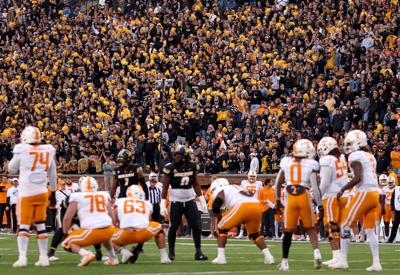
Mizzou fans cheer as the Tennessee Volunteers try to call an audible during an SEC football game Saturday, Nov. 11, 2023, on Faurot Field at Memorial Stadium in Columbia, Mo.
COLUMBIA, Mo. — The artificial turf that occupies Faurot Field could become a little bit greener soon. The surface can’t grow grass, but it can grow Missouri athletics’ revenue stream under an NCAA rule change the university is prepared to leverage.
Schools can now place sponsor logos in up to three spots on their football fields, the NCAA decided Thursday, and that has immediate appeal for Mizzou.
“Absolutely,” MU athletics director Laird Veatch told the Post-Dispatch when asked whether he’s interested in finding the right sponsor for a logo on Memorial Stadium’s playing surface. “It has to be an interest. It has to be something that we take and present as opportunities to partners like that — that want to help us but also want to really help their brand and their company. Those are huge opportunities.”
What logos could wind up placed on Faurot Field and what they would look like remains to be seen. The NCAA Playing Rules Oversight Panel moved to allow the advertisements Thursday afternoon, so the logistics are still hazy.
People are also reading…
If they choose to display them, schools can place an advertisement centered on the 50-yard line along and two smaller flanking logos elsewhere on the field — likely around the 25-yard line.
Those latter locations seem to have more immediate appeal than replacing a university logo in the middle of the field with a corporate insignia — particularly in the tradition-rich Southeastern Conference.
Sponsorship deals for on-field advertisements around the 25-yard line would likely bring in at least $1 million per season for SEC programs, , citing industry sources.
On-field logos can be swapped out game-by-game or run across an entire season, depending on schools’ preferences.
Part of the NCAA’s rationale for making the rule change is to align the policies for regular season home games with the regulations for postseason, neutral-site bowl games that are heavily sponsored.
And it’s readily available revenue at a time when schools need it, with the need to share revenue with student-athletes to the likely tune of $20 million to $22 million per year on the horizon.
“This change allows schools to generate additional income to support student-athletes,” NCAA President Charlie Baker said in a statement. “I’m pleased that we could find flexibility within our rules to make this happen for member schools.”
Veatch agrees with that reasoning.
“I’m really encouraged to see that, nationally, we’re also evolving on that side because we’re going to need more and more corporate support,” he said. “Those types of opportunities, we have to be — I believe — aggressive with. We have to really look to leverage those kinds of things because the price to compete is going up.”
Through his first month on the job at MU, Veatch has made securing more corporate support one of his early priorities. On-field advertisements are just another front for that effort.
“It’s just an incredible branding, exposure opportunity for a company or business,” he said. “But we need to look for other opportunities that are new and different, particularly now that you can really incorporate true NIL (name, image, likeness marketing) with student-athletes and create that connection, that direct, personal connection with a young face and name and personality. It’s a whole new era and corporate partnership, that’s another great thing.”
The next frontier of increased advertising in college football could eventually come in the form of jersey patches representing sponsors.
Those have already entered professional sports like Major League Baseball, the National Basketball Association and soccer leagues around the world. Sponsorship deals for logo patches would likely be worth several times more than on-field advertisements if college football embraces them.
Veatch didn’t conclusively say whether he’s for or against putting commercial logos on uniforms, but he is intrigued by what it could offer.
“I think we need to explore all those kinds of opportunities, collectively,” he said. “Now, that hasn’t been something that’s received a lot of discussion yet, but I think it needs to. I do believe we need to be exploring all those kinds of opportunities because it’s going to also continue to help us provide more support for student-athletes.”
















